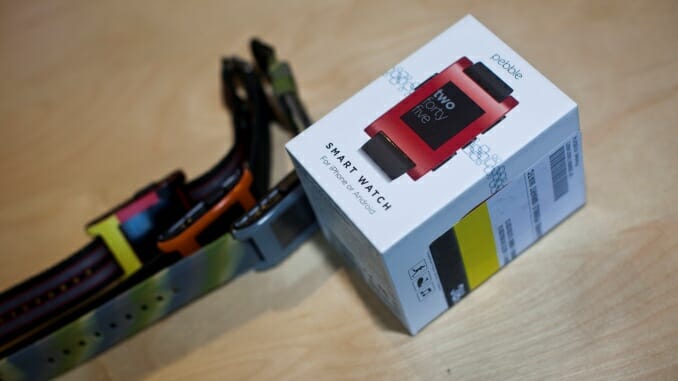The Pebble Smartwatch’s Legacy Remains 10 Years On: ‘We Invented The Smartwatch’
Photo via Ramin Talaie/Corbis via Getty Images
If you’re crafting a list of influential tech giants, Pebble Technology probably isn’t all that close to the top of it. But had a few things gone a bit differently over the past few years? It could’ve been. Apple Watches and Fitbits are ubiquitous today. But flashback a decade ago, and the idea of smartwatches and wearable technology was nascent, nerdy and largely unproven.
It was in that wild west of consumer technology, circa 2012, that Pebble Technology decided to take its burgeoning smartwatch expertise to the masses with a crowdfunding campaign to offer the company’s first formal product: the Pebble watch. As Pebble founder Eric Migicovsky explained to Paste, his team already had some experience figuring out the tentpoles of how a potential smartwatch might work, having started back in 2008 with the inPulse watch designed for Blackberry phones (it found some modest success, but didn’t move the needle).
Looking to do something more ambitious with broader appeal, Migicovsky and his team developed the Pebble watch and decided to sidestep more traditional tech funding routes and took their pitch straight to consumers on Kickstarter. They hoped to raise $100,000 to get a modest run of Pebble watches produced. When the campaign’s clock hit zero, they’d raised more than $10 million.
“The night before our campaign started the four of us at Pebble were making predictions about how much money we’d raise on Kickstarter,” Migicovsky said. “Our original goal was $100,000 for the month-long campaign. I realistically thought we might raise $5,000 on the first day. Our intern was the most optimistic, he thought we’d get $20,000. In the first 24 hours we raised $500,000. It felt incredible.”
Pebble would spend years atop Kickstarter’s record book, and the company’s product line remains among the most successful crowdfunding projects in history. Pebble would go on to release multiple lines of watches, ranging from the more professional Pebble Steel, the very watch-like Pebble Round (which eschewed the typical square smartwatch design for a round face), and the company’s final project: the fun, almost Swatch-like Pebble Time 2.
Along the way, the company pioneered what a smartwatch could do and how it should function, developing health and data tracking features, notification and calendar functions, all largely from scratch. Instead of a touchscreen, Pebble watches used chunky, physical side buttons for navigation. The watches also used energy-efficient E-Paper screens, which meant a typical Pebble watch could run for weeks and weeks on a single charge — which as anyone who has to charge their Apple Watch twice per day can attest — remains a killer feature.
Though it obviously made the Pebble cheaper to manufacture, Migicovsky said he actually preferred the physical buttons over a touchscreen, since physical buttons can be easier to navigate without looking. “I loved having physical buttons and still can’t really stand using any smartwatch without them,” he said. “I love being able to blindly pause my music or reject an incoming call.”
Pebble watches were compatible with iOS and Android phones, and sometimes pushed the boundaries to bring as many features as possible to their users, though that meant Pebble sometimes butted heads with Apple as they tried to wring as much functionality as possible out of Apple’s notoriously closed ecosystem.
Though Pebble developed a dedicated, fervent user base that was happy to back every new Kickstarter and upgrade to the newest watch every year or so, the company’s products still never broke through to the mainstream. They became fan-favorite gadgets among techies and early adopters, but as the market got a whole lot more competitive with the release of the Apple Watch and more refined fitness trackers, Pebble’s niche remained just that — a niche.
-

-

-

-

-

-

-

-

-

-

-

-

-

-

-

-

-

-

-

-

-

-

-

-

-

-

-

-

-

-

-

-

-

-

-

-

-

-

-

-








































